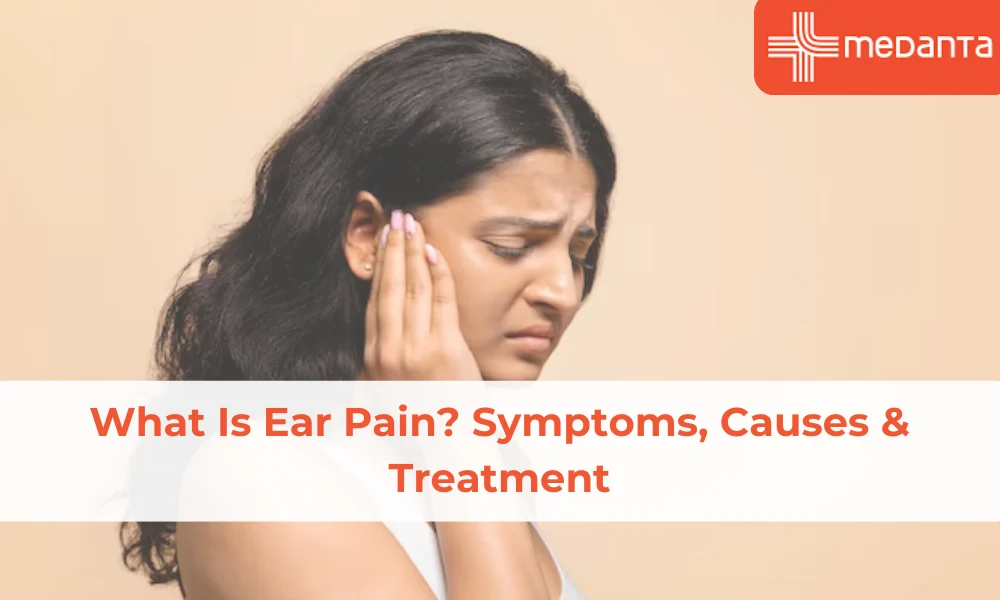What Is Ear Pain? Symptoms, Causes & Treatment

TABLE OF CONTENTS
What Is Ear Pain? Symptoms, Causes & Treatment
Earaches may be a symptom of an underlying ailment, such as an ear infection, or they may be a warning indication. Ear pain or discomfort in the ear is not always an indication of anything more severe. Treatment is targeted to correct the root issue. Within two to three days of taking antibiotics for an bacterial ear infection, you should begin to see a reduction in Ear Pain symptoms.
Excess fluid in the middle part of the ear (middle ear) and infections are common causes of earache that may impair hearing. It's possible that an underlying long standing medical condition (like Uncontrolled Diabetes) itself may cause ear discomfort and my predispose to ear infections.
Other common reasons of ear pain include:
Wearing tight headgear
Smaller mask
Sleeping on a hard surface
Ear piercings
Grinding teeth
Foreign body in the ear canal
Impacted wax
Injury to the ear canal skin after probing with ear buds or anything alike
Children are more likely to develop earache (otalgia) than adults. Primary otalgia is pain that arises within the ear, while secondary otalgia originates outside the ear. The onset of ear discomfort might be gradual or abrupt. Mild pain or severe, piercing pain might be experienced, and it can be short-term or long-term. Most of the time, the discomfort only affects one ear, although it might be present in both.
Ear Pain Signs and Symptoms
Ear discomfort may cause a variety of symptoms, including:
Fever
Damage to the auditory canal
Inability to hear
Headache
Inability to swallow
Jaw aches
A popping or clicking sound
Anxiety and agitation (in children)
Crying has been more frequent (in children)
A decrease in hunger (in children)
Causes:
Injuries, infections, ear irritation, or referred pain may all lead to Ear Pain. Pain that originates elsewhere than the site of illness or damage is known as "referred pain." An example is discomfort in the ear that develops in the jaw or teeth. Earaches may be caused by:
An Ear Infection is an infection in the ear canal.
Ear infections are a significant cause of ear pain and discomfort. The outer, middle, and inner ear may all be infected.
Wearing hearing aids or headphones that are larger than the ear canal that injure the ear canal's skin may result in an outer-ear infection, as can sticking cotton-swabbed fingers into the canal.
An infection may develop if the skin in the ear canal is scratched. Ear canal skin may become a breeding ground for germs (bacteria and fungus).
An upper respiratory tract infection might cause a middle ear infection as well. These infections may proliferate germs in the fluid that collects behind the eardrums.
Labyrinthitis is an inner ear ailment that may be brought on by viral or bacterial infections of respiratory tract.
In addition to earaches, there are many other prevalent reasons for them:
When you're on a plane and the pressure changes
Wax buildup in the ears
An item lodged in the ear canal
A sore throat
Infection of the nasal sinuses
The ear canal may be clogged with shampoo or water.
Cleaning the ear canal with cotton swabs
More uncommon causes of Ear pains:
Temporomandibular joint syndrome (TMJ)
Eardrum perforation
A jaw-related kind of arthritis
An impacted tooth
Ear canal eczema
Neuralgia of the trigeminal nerves (chronic pain of the facial nerve)
Diagnosis:
There is no need to contact a doctor for adults and older children with minor hearing discomfort or pressure in the ear without a fever or hearing loss. A clogged eustachian tube is the most common cause of this sort of discomfort.
You should seek medical attention if the pain in your ears is more acute or if there are additional symptoms. To check for redness and fluid accumulation behind the eardrum, your ENT specialist will use an otoscope (lighted equipment) to look into your ears. The otoscope may be used to send a puff of air into your ear to check the eardrum's proper movement.
Your doctor may do a hearing evaluation to check if your hearing is normal or abnormal.
Treatment:
The underlying reason often determines ear pain treatment. Drugs and surgery are among the most common treatment options, and the choice of treatment depend on the reason of the ailment and the damage it has caused.
Medication:
Over-the-counter (OTC) drugs like Tylenol (acetaminophen) and ibuprofen (Advil) may be prescribed by your doctor to ease ear discomfort (Advil, Motrin). Even if your doctor recommends over-the-counter ear drops, you should never take them if you are in danger of rupturing your eardrum.
Most of the time, antibiotics are not required for Ear Pain treatment. Medications such as amoxicillin may be prescribed in children with severe ear infections or infections that last for more than a few days.
A build-up of earwax may cause ear pain. Avoid using cotton swabs or any other object to remove wax from your ear, as doing so will push it further into your ear. A medical practitioner should be consulted to determine the cause of the excessive build-up of earwax and prescribe the appropriate course of treatment.
Surgery:
The insertion of a tiny tube into the eardrums of children who suffer from earaches due to fluid in the middle ear. For the most part, short-term tubes come out on their own within six to nine months after being put in.
Is it possible to avoid Ear pains?
There are several causes of earaches. The good news is that there are activities you may do to lessen your chances of getting ear pain:
Avoid barotrauma by taking precautions with your ears while flying.
Carefully remove any wax or debris from your ears. To prevent damaging your ear canal, wipe your outer ear with a swab rather than digging into it.
Ear discomfort and infection are common symptoms of upper respiratory tract infections. Washing your hands often, especially if you frequently contact your nose, eyes, or mouth, may help prevent the spread of germs.
Infections of the middle ear (otitis media) and the ear canal (swimmer's ear) are common causes of ear discomfort (otitis externa). Ear infections are more common in children than adults, although they may occur in anybody. Ear pain in adults may be caused by various medical disorders, including uncontrolle






